LHAASO (Large High Altitude Air Shower Observatory)
Astronomy and Telescopes
LHAASO (Large High Altitude Air Shower Observatory)
Status Basic architecture References
LHAASO is a gamma-ray and cosmic-ray observatory in Daocheng, in the Garzê Tibetan Autonomous Prefecture in Sichuan, China. It is designed to observe air showers triggered by gamma rays and cosmic rays. The observatory is at an altitude of 4,410 meters above sea level. Observations started in April 2019.
The National Development and Reform Commission, China's top economic planning body, approved the LHAASO (Large High Altitude Air Shower Observatory) project on December 31, 2015. The LHAASO project is designed to explore physics goals in gamma ray astronomy and cosmic ray physics. 1) 2)
The main scientific objectives of LHAASO are to search for the origin of high energy cosmic rays, to study the evolution of the universe and high energy celestial bodies, and to push forward the frontier of new physics. Statistical samples of various gamma ray sources will be accumulated through an all-sky gamma ray source survey and precise measurement of gamma ray energy spectra. Internationally, LHAASO will be a key frontier project for cosmic ray research.
Work on the project started in 2008, when scientists at the IHEP (Institute of High Energy Physics) initiated a pre-study and conducted extensive field surveys in China's high-altitude areas. In 2014, the highlands at Daocheng County, Sichuan, where there is an average altitude of 4400 meters, was selected as the observation station site. In August 2014, the Chinese Academy of Sciences and the Sichuan provincial government signed a framework agreement to build the LHAASO project, marking the establishing of a scientific base in Sichuan for the international forefront of cosmic ray research.
Over one hundred scientists from more than 20 Chinese research institutions and researchers from Italy, France, Russia and other countries have joined LHAASO. The total cost of the project is projected at 1.2 billion yuan, with an estimated construction time of four years.

The aim of LHAASO is the development of an air shower experiment able to monitor with unprecedented sensitivity the gamma ray sky at energies from ~200 GeV to 1 PeV (corresponding to 200 x 109 to 1015 eV), and at the same time be an instrument able to measure the cosmic ray spectrum, composition and anisotropy in a wide energy range (~1 TeV to 1 EeV corresponding to 1012 to 1018 eV). LHAASO, thanks to the large area and the high capability of background rejection, can reach sensitivities to gamma ray fluxes above 30 TeV that are about 100 times higher than that of current instruments, offering the possibility to monitor for the first time the gamma ray sky up to PeV energies and to discover the long sought "Pevatrons". 3)
The observatory covers an area of some 145 hectares (360 acres). It has three underground observing pools, each “more than triple the size of the Water Cube (National Aquatic Center) in Beijing”. One of the pools is designed to contain 100,000 tons of water (corresponds to 100,000 m3). The pools will contain 12 telescopes to capture high-energy photons. Cherenkov radiation detectors are used. Research teams from Australia and Thailand will participate in the project directly, with others expressing interest. 4)
Discovered in 1912, cosmic rays are still largely an enigma. They are direct samples of matter from outside the solar system. Physicists are still pondering where they come from and how they can be accelerated to ultra-high energies.
Now scientists have found most cosmic rays are atomic nuclei. All the natural elements in the periodic table are present in cosmic rays. About 90 percent of them are the nuclei of hydrogen (protons); about 9 percent are helium nuclei (alpha particles); and the other heavier elements, electrons, gamma rays, neutrinos and antimatter particles make up the other 1 percent.
Since most cosmic rays are charged, their paths through space are deflected by magnetic fields. On their journey to Earth, the magnetic fields of the galaxy, the solar system, and the earth scramble their flight paths so much that we can no longer know exactly where they came from.
As cosmic rays rocket away from their sources, they also emit photons, usually about one-tenth as energetic as the cosmic rays themselves, that follow a straight path to Earth. Although Earth’s atmosphere blocks this gamma ray light, when the photons slam into air molecules, they create showers of secondary particles and faint blue Cherenkov light that astronomers can look for.
China's LHAASO aims to catch the air showers associated with the highest energy gamma rays, which in turn correspond to the highest energy cosmic rays. LHAASO is a cluster of detectors spanning more than 1 km2 on Haizi Mountain, 4410 meters above sea level in Sichuan province. More than 5000 detectors spread across the site capture particles associated with the highest energy strikes, while more than 1000 muon detectors, buried underground, help rule out particle showers associated with unrelated cosmic rays that constantly pepper Earth. Before LHAASO began operations in 2019, most detectors worked in much lower energy bands. But the new results show the universe is capable of far higher accelerations.
Mission Status
• May 17, 2021: China's LHAASO — one of the country's key national science and technology infrastructure facilities — has found a dozen ultra-high-energy (UHE) cosmic accelerators within the Milky Way. It has also detected photons with energies exceeding 1 peta-electron-volt (1 x 1015 PeV), including one at 1.4 PeV. The latter is the highest energy photon ever observed. 5)
- These findings overturn the traditional understanding of the Milky Way and open up an era of UHE gamma astronomy. These observations will prompt people to rethink the mechanism by which high-energy particles are generated and propagated in the Milky Way, and will encourage people to explore more deeply violent celestial phenomena and their physical processes as well as test basic physical laws under extreme conditions.
- These discoveries are published in the journal Nature on May 17. The LHAASO International Collaboration, which is led by the Institute of High Energy Physics (IHEP) of the Chinese Academy of Sciences, completed this study. 6)
- The LHAASO Observatory is still under construction. The cosmic accelerators—known as PeVatrons since they accelerate particles to the PeV range—and PeV photons were discovered using the first half of the detection array, which was finished at the end of 2019 and operated for 11 months in 2020.
- Photons with energies exceeding 1 PeV were detected in a very active star-forming region in the constellation Cygnus. LHAASO also detected 12 stable gamma ray sources with energies up to about 1 PeV and significances of the photon signals seven standard deviations greater than the surrounding background. These sources are located at positions in our galaxy that can be measured with an accuracy better than 0.3°. They are the brightest Milky Way gamma ray sources in LHAASO's field of view.
- Although the accumulated data from the first 11 months of operation only allowed people to observe those sources, all of them emit so-called UHE photons, i.e., gamma rays above 0.1 PeV. The results show that the Milky Way is full of PeVatrons, while the largest accelerator on Earth (LHC at CERN) can only accelerate particles to 0.01 PeV. Scientists have already determined that cosmic ray accelerators in the Milky Way have an energy limit. Until now, the predicted limit was around 0.1 PeV, thus leading to a natural cut-off of the gamma-ray spectrum above that.
- But LHAASO's discovery has increased this “limit,” since the spectra of most sources are not truncated. These findings launch an era for UHE gamma astronomic observation. They show that non-thermal radiation celestials, such as young massive star clusters, supernova remnants, pulsar wind nebulas and so on—represented by Cygnus star-forming regions and the Crab nebula—are the best candidates for finding UHE cosmic rays in the Milky Way.
- Through UHE gamma astronomy, a century-old mystery — the origin of cosmic rays — may soon be solved. LHAASO will prompt scientists to rethink the mechanisms of high energy cosmic ray acceleration and propagation in the Milky Way. It will also allow scientists to explore extreme astrophysical phenomena and their corresponding processes, thus enabling examination of the basic laws of physics under extreme conditions.

Core Scientific Goals
- LHAASO is a major national scientific and technological infrastructure facility focusing on cosmic ray observation and research. It is located 4,410 meters above sea level on Mt. Haizi in Daocheng County, Sichuan Province. When construction is completed in 2021, LHAASO’s particle detector arrays will comprise 5,195 electromagnetic particle detectors and 1,188 Muon detectors located in the square-kilometer complex array (KM2A), a 78,000 m2 WCDA (Water Cherenkov Detector Array), and 18 wide-field-of-view Cherenkov telescopes (WFCTA). Using these four detection techniques, LHAASO will be able to measure cosmic rays omnidirectionally with multiple variables simultaneously. The arrays will cover an area of about 1.36 km2.
- LHAASO's core scientific goal is to explore the origin of high-energy cosmic rays and study related physics such as the evolution of the universe, the motion and interaction of high-energy astronomical celestials, and the nature of dark matter. LHAASO will extensively survey the universe (especially the Milky Way) for gamma ray sources. It will precisely measure their energy spectra over a broad range—from less than 1 TeV (1012 eV) to more than 1 PeV (1015 eV). It will also measure the components of diffused cosmic rays and their spectra at even higher energies, thus revealing the laws of the generation, acceleration and propagation of cosmic rays, as part of the exploration of new physics frontiers.
PeVatrons and PeV Photons
- The signal of UHE photons around PeVatrons is so weak that just one or two photons at PeV energy can be detected using 1 km2 of detectors per year even when focusing on the Crab Nebula, known as the “standard candle for gamma astronomy.” What's worse, those one or two photons are submerged in tens of thousands of ordinary cosmic rays. The 1,188 muon detectors in LHAASO's KM2A are designed to select photon-like signals, making LHAASO the most sensitive UHE gamma ray detector in the world. With its unprecedented sensitivity, in just 11 months, the half-sized KM2A detected one photon around 1 PeV from the Crab Nebula. In addition, KM2A found 12 similar sources in the Milky Way, all of which emit UHE photons and extend their spectra continuously into the vicinity of 1 PeV. Even more important, KM2A has detected a photon with energy of 1.4 PeV—the highest ever recorded. It is clear that LHAASO's scientific discoveries represent a milestone in identifying the origin of cosmic rays. To be specific, LHAASO's scientific breakthroughs fall into the following three areas:
1) Revealing the ubiquity of cosmic accelerators capable of accelerating particles to energies exceeding 1 PeV in the Milky Way. All the gamma ray sources that LHAASO has effectively observed radiate photons in the UHE range above 0.1 PeV, indicating that the energy of the parent particles radiating these gamma rays must exceed 1 PeV. As a matter of convention, these sources must have significances of photon signals five standard deviations greater than the surrounding background. The observed energy spectrum of these gamma rays has not truncated above 0.1 peV, demonstrating that there is no acceleration limit below PeV in the galactic accelerators.
- This observation violates the prevailing theoretical model. According to current theory, cosmic rays with energies in the PeV range can produce gamma rays of 0.1 PeV by interacting with surrounding gases in the accelerating region. Detecting gamma rays with energies greater than 0.1 PeV is an important way to find and verify PeV cosmic ray sources. Since previous international mainstream detectors work below this energy level, the existence of PeV cosmic ray accelerators had not been solidly confirmed before. But now LHAASO has revealed a large number of PeV cosmic acceleration sources in the Milky Way, all of which are candidates for being UHE cosmic ray generators. This is a crucial step toward determining the origin of cosmic rays.
2) Beginning an era of “UHE gamma astronomy.” In 1989, an experimental group at the Whipple Observatory in Arizona successfully discovered the first object emitting gamma radiation above 0.1 TeV, marking the onset of the era of “very-high-energy” gamma astronomy. Over the next 30 years, more than 200 “very-high-energy” gamma ray sources were discovered. However, the first object emitting UHE gamma radiation was not detected until 2019. Surprisingly, by using a partly complete array for less than a year, LHAASO has already boosted the number of UHE gamma ray sources to 12.
- With the completion of LHAASO and the continuous accumulation of data, we can anticipate to find an unexplored “UHE universe” full of surprising phenomena. It is well known that background radiation from the Big Bang is so pervasive it can absorb gamma rays with energies greater than 1 PeV. Even if gamma rays were produced beyond the Milky Way, we wouldn't be able to detect them. This makes LHAASO's observational window so special.
3) Photons with energies greater than 1 PeV were first detected from the Cygnus region and the Crab Nebula. The detection of PeV photons is a milestone in gamma astronomy. It fulfills the dream of the gamma astronomy community and has long been a strong driving force in the development of research instruments in the field. In fact, one of the main reasons for the explosion of gamma astronomy in the 1980s was the challenge of the PeV photon limit. The star-forming region in the direction of Cygnus is the brightest area in the northern territory of the Milky Way, with a large number of massive star clusters. Massive stars live only on the order of one million years, so the clusters contain enormous stars in the process of birth and death, with a complex strong shock environment. They are ideal “particle astrophysics laboratories,” i.e., places for accelerating cosmic rays.
- The first PeV photons found by LHAASO were from the star-forming region of the constellation Cygnus, making this area the best candidate for exploring the origin of UHE cosmic rays. Therefore, much attention has turned to LHAASO and multi-wavelength observation of this region, which could offer a potential breakthrough in solving the “mystery of the century.”
- Extensive observational studies of the Crab Nebula over the years have made the celestial body almost the only standard gamma ray source with a clear emission mechanism. Indeed, precise spectrum measurements across 22 orders of magnitude clearly reveal the signature of an electron accelerator. However, the UHE spectra measured by LHAASO, especially photons at PeV energy, seriously challenge this “standard model” of high-energy astrophysics and even the more fundamental theory of electron acceleration.
Technology Innovations
- LHAASO has developed and/or improved: 1) clock synchronization technology over long distances that ensures timing synchronization accuracy to the sub-nanosecond level for each detector in the array; 2) multiple parallel event trigger algorithms and their realization, with the help of high-speed front-end signal digitization, high-speed data transmission and large on-site computing clusters; and advanced detection technologies include 3) silicon photo multipliers (SiPM) and 4) ultra-large photocathode micro-channel plate photomultiplier tubes (MCP-PMT). They are being employed at LHAASO on a large scale for the first time. They have greatly improved the spatial resolution of photon measurements and lowered the detection energy threshold. These features allow detectors to achieve unprecedented sensitivity in exploring the deep universe at a wide energy range. LHAASO provides an attractive experimental platform for conducting interdisciplinary research in frontier sciences such as atmosphere, high-altitude environment and space weather. It will also serve as a base for international cooperation on high-level scientific research projects.
History of Cosmic Ray Research in China
- Cosmic ray research in China has experienced three stages. LHAASO represents the third generation of high-altitude cosmic ray observatories. High-altitude experiments are a means of making full use of the atmosphere as a detector medium. In this way, scientists can observe cosmic rays on the ground, where the size of the detector can be much larger than in a space-borne detector outside the atmosphere. This is the only way to observe cosmic rays at very high energy.
- In 1954, China's first cosmic ray laboratory was built on Mt. Luoxue in Dongchuan, Yunnan Province, at 3,180 meters above sea level. In 1989, the Sino-Japanese cosmic ray experiment ASg was built at an altitude of 4,300 meters above sea level at Yangbajing, Tibet Autonomous Region.
- In 2006, the joint Sino-Italian ARGO-YBJ experiment was built at the same site.
- In 2009, at the Xiangshan Science Forum in Beijing, Professor CAO Zhen proposed to build a large-scale composite detection array (i.e., LHAASO) in a high-altitude area. The LHAASO project was approved in 2015 and construction began in 2017. By April 2019, construction was 25% complete and scientific operation had begun. By January 2020, an additional 25% had been completed and put into operation. In December of the same year, 75% of the facility had been completed. The entire facility will be completed in 2021. LHAASO has already become one of the world's leading UHE gamma detection facilities, and will operate for a long time. With it, scientists will be able to study the origin of cosmic rays from many aspects.
• January 7, 2021: Construction on the WCDA (Water Cherenkov Detector Array) at LHAASO has been completed and the array is now in operation as of the beginning of 2021, according to the Institute of High Energy Physics (IHEP) of the Chinese Academy of Sciences. LHAASO is one of the country's Ministry of S&T (Science & Technology) infrastructure mega projects. 7) 8)
- Water in the WCDA's last pond has now reached its design level of 4.3 meters after being filled over a period of two months that ended after the New Year's break. Now, all three ponds at the WCDA are completely operational. This is the first of four major component arrays at LHAASO to be finished. LHAASO is located in Daocheng, Sichuan, China at 4410 m above sea level. It comprises an array of 5242 electromagnetic detectors and 1188 muon detectors, an array of 18 wide field-of-view Cherenkov telescopes, and the WCDA. LHAASO combines multiple cosmic ray detection technologies for exploring the origin of cosmic rays. It is well-suited for all-sky surveying for gamma ray sources due to its unprecedented sensitivity, particularly at gamma ray energies above 10 TeV. It can also serve as a charged cosmic ray detector covering the energy range from 1014 eV to 1018 eV.
- The WCDA consists of two ponds measuring 150 m x 150 m (#1 and #2) and one measuring 300 m x 110 m (#3), for a total area of 78,000 m2. The whole array has 3120 detector units equipped with 6240 photo sensors, namely photomultiplier tubes (PMT). Construction began in June 2017 and detector deployment was completed in October 2020. Pond #1 commenced scientific operation in April 2019 and pond #2 in November 2019.
- The ponds were filled with 350,000 m3 of clean water during the winters of 2018-2020 due to construction scheduling and better water quality in winter. The warmer seasons were reserved for concrete polling, construction of the steel structure and roof, and detector deployment. The project faced huge difficulties due to the need to keep the ~1 km-long pipelines from freezing at -20° Celsius at night as well as a lack of water during the dry winters. People in charge of operations made tremendous efforts to ensure a smooth process of water production and filling over a total of 3000 hours. Deployment teams from IHEP, the University of Science and Technology, Sichuan University, Shandong University, Tsinghua University and the National Space Science Center successfully completed the job by overcoming problems such as a lack of oxygen, coldness and heavy humidity in the ponds.
- In order to respond to strong progress in multi-messenger astronomy in recent years, the design for the WCDA was modified. The original design, which called for traditional 8-inch PMTs, was replaced with newly developed 20-inch PMTs. Therefore, the WCDA's sensitivity to photons at energies between 50 GeV and 500 GeV (1 GeV = 109 electron-volt) has been greatly enhanced. This means that the effective area and sensitivity are four and six times better, respectively, than similar existing instruments.
- With this lower threshold, the WCDA enables detection of many sources inside and outside our galaxy, including gamma ray bursts (GRB), fast radio bursts (FRB), blazars and even electromagnetic counterparts of gravitational waves. Many interesting observational studies on these transient phenomena are expected with the smooth operation of the WCDA in the near future. Moreover, in combination with the 1 km2 scintillator and muon counter arrays that surround the WCDA, LHAASO can measure gamma ray photons from galactic sources that span four orders of magnitude from 1011 eV to 1015 eV. In this way, the WCDA plays an essential role in the attempt to unravel the mystery of the origin of ultra-high energy cosmic rays and the mechanism of ultra-high energy radiation from cosmic ray sources.
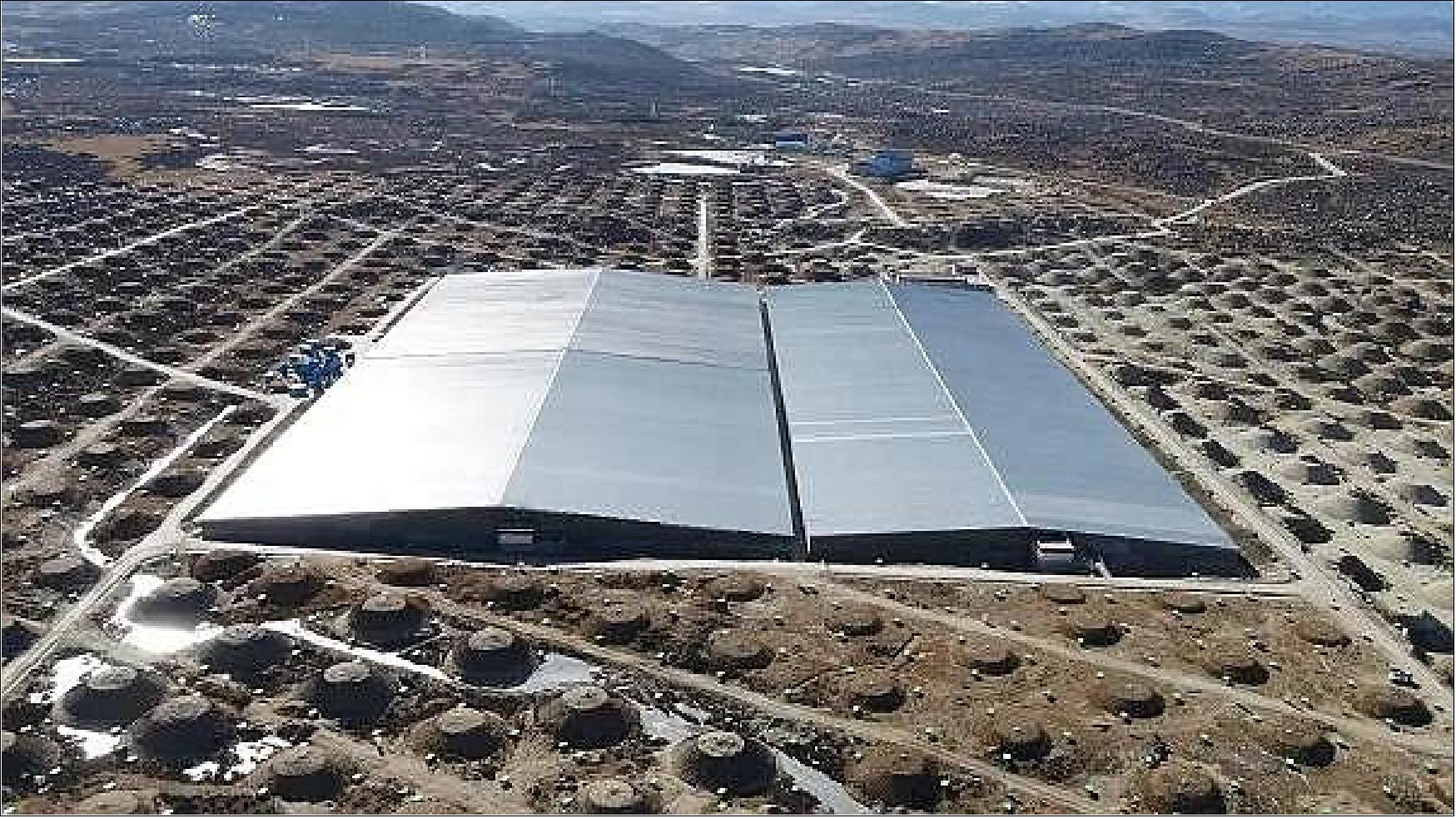



• April 22, 2019: China's Large High Altitude Air Shower Observatory (LHAASO), a cosmic ray detection facility located in the high mountains of Sichuan province, recently began scientific observation of very high energy cosmic rays as it launched operation of its first set of detectors. 9)
- The goal of LHAASO, which will be completed in 2021, is to discover high energy gamma ray sources, and precisely measure the radiation spectrum of very high energy gamma ray sources and energy spectra of various cosmic ray species over a wide range.
- LHAASO's Phase One detectors include the No. 1 Water Cherenkov Detector Array (WCDA-1) with an active area of 2.25 hectares, as well as two wide-field Cherenkov telescopes and 80 muon detectors (MDs) and 180 electromagnetic detectors (EDs).
- The full scale WCDA, which will eventually comprise three ponds, is designed to survey for gamma ray sources above 50 billion eV. Assisted by the rotation of the Earth, the WCDA will be able to scan over 60% of the sky each day. It won't be affected by the light of the sun, moon or stars or by the weather, thus ensuring round-the-clock observation. In the future, the WCDA will be able to record 5 trillion cosmic ray detections each year and obtain more than 4PB of data.
- WCDA-1, which has commenced scientific operation, is composed of 900 units. Each is equipped with an 8-inch and a 1.5-inch photomultiplier tube. Already, the sky-surveying sensitivity of WCDA-1 is slightly higher than another international facility, the HAWC Experiment in Mexico built mainly by the United States and Mexico. Wide and deep collaboration between LHAASO and other facilities, including HAWC, will be expected in the detection of the high energy radiation of gamma-ray bursts (GRBs), the detection and observation of extragalactic blazars and the high precision observation of gamma ray sources in the Milky Way, among other activities.
- LHAASO is expected to make breakthroughs concerning the origin of cosmic rays, according to Prof. Cao Zhen, LHAASO's chief scientist and an astrophysicist from the Institute of High Energy Physics (IHEP) of the Chinese Academy of Sciences. Prof. Cao noted that the origin of cosmic rays“has puzzled the world for over a hundred years.”
- Both international and domestic experts have been invited to observe and discuss LHAASO's work. This broad outreach is in line with LHAASO's goal of international scientific collaboration.
- Prof. Wang Yifang, IHEP director, said that astronomical observation “has entered the era of combining multi-wavelength observations and multi-messenger studies together.” He emphasized that LHAASO would enhance major international astronomical observation efforts and boost the progress of such research.
More About LHAASO
- LHAASO is one of China's major national science and technology infrastructure projects and is located in the Mt. Haizi National Reservation at 4,400 meters above sea level. The project was approved as part of the country's “12th Five-year Plan” (2011-2015). Construction began in June 2016 and is expected to be completed in 2021. Since detectors are being distributed across a wide area, LHAASO has begun observation even as construction continues elsewhere on the site.
- LHAASO will comprise an array of 5,195 electromagnetic detectors (EDs); an array of 1,171 muon detectors (MDs); a Water Cherenkov Detector Array (WCDA) spanning three ponds with a total active area of 7.8 hectares; and an array of 12 wide-field Cherenkov telescopes (WFCTA), distributed in an open space of 1.3 km2.
- LHAASO is expected to achieve a gamma ray sky-surveying sensitivity of 1% crab (the gamma intensity of the standard candle) above 50 billion eV and precise measurement of gamma ray spectra of sources above 50 trillion eV – an unprecedentedly high level of sensitivity and energy. LHAASO is also expected to measure the spectra of cosmic ray species at high precision from 5 x 1013 eV to 1018 eV.




Basic Architecture
The LHAASO (Large High Altitude Air Shower Observatory) experiment was proposed for very high energy gamma ray source survey, in which the WCDA (Water Cherenkov Detector Array) is the one of the major components. In the WCDA, a total of 3600 PMTs (Photomultiplier Tubes) are placed under water in four ponds, each with a size of 150 m x 150 m. Precise time and charge measurement is required for the PMT signals, over a large signal amplitude range from single PE (Photo Electron) to 4000 PE. To fulfill the high requirement of signal measurement in so many front end nodes scattered in a large area, special techniques are developed, such as multiple gain readout, hybrid transmission of clocks, commands, and data, precise clock phase alignment, and new trigger electronics. We present the readout electronics architecture for the WCDA and several prototype modules, which are now under test in the laboratory. 10)
Gamma ray source detection above 30 TeV is an encouraging approach for finding galactic cosmic ray sources. All sky survey for gamma ray sources is essential for population accumulation for various types of sources above 100 GeV. To target these goals, the Large High Altitude Air Shower Observatory (LHAASO) is proposed, with multiple air shower detection techniques combined together. As shown in Figure 11, the LHAASO mainly consists of a KM2A (1 km2complex array), a WCDA (Water Cherenkov Detector Array), a WFCTA (Wide FOV Cherenkov Telescope Array) and a SCDA (high threshold core-detector array).
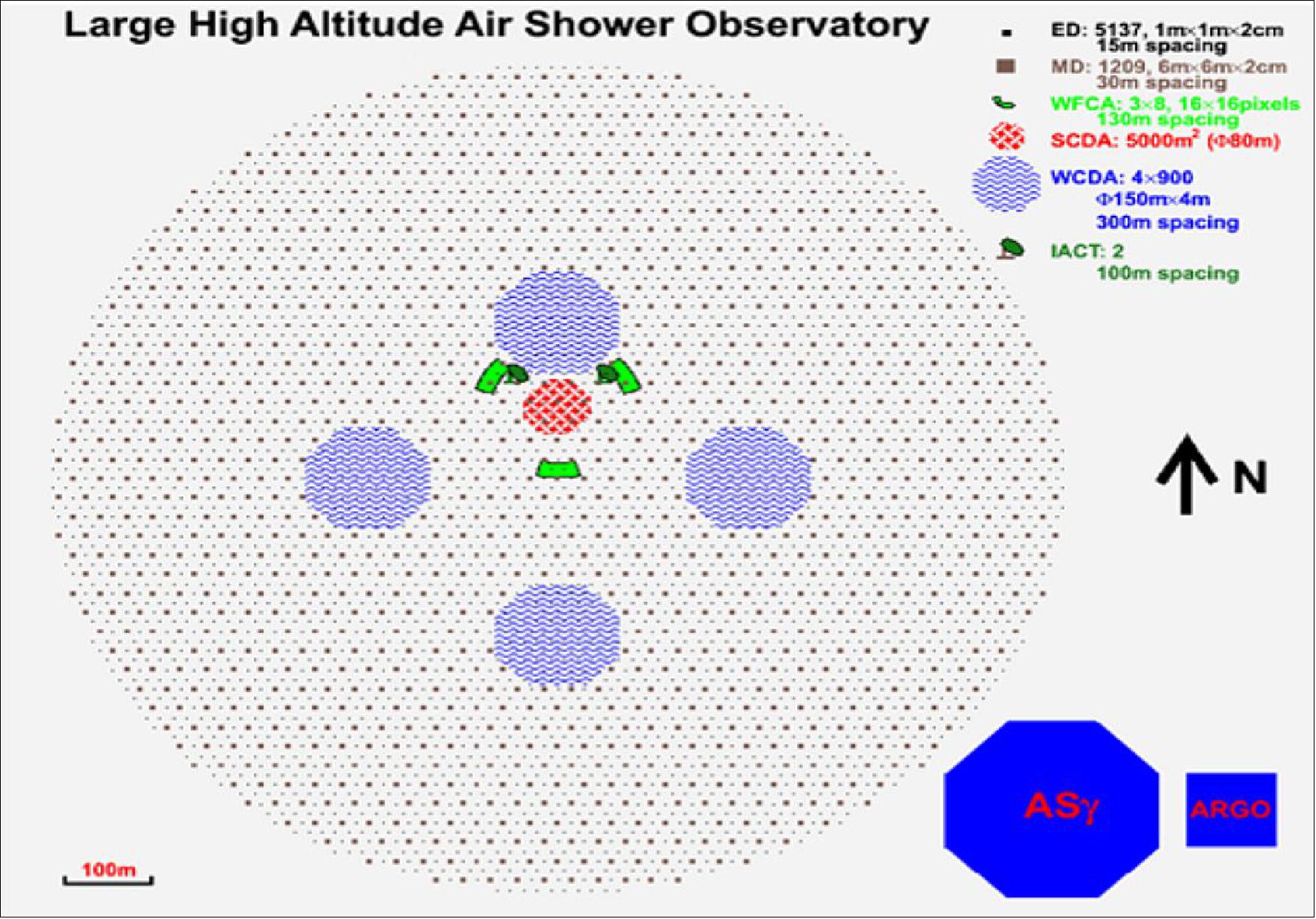
As one of the major components in LHAASO, the WCDA consists of four 150 m x 150 m ponds, as marked by the four octagons in Figure 11 and thus a total area of 90,000 m2 is covered. Every pond incorporates 900 detector cells (5 m x 5 m), each with one photomultiplier tube(PMT) looking up at the bottom center to collect the Cherenkov light produced by the shower particles in water. This detector array of 900 cells is partitioned into 10 x 10 detector units, as shown in Figure 11.Each unit contains 3 x 3 PMTs and their outputs are fed to one front end electronics module (FEE) for charge and time information measurement.
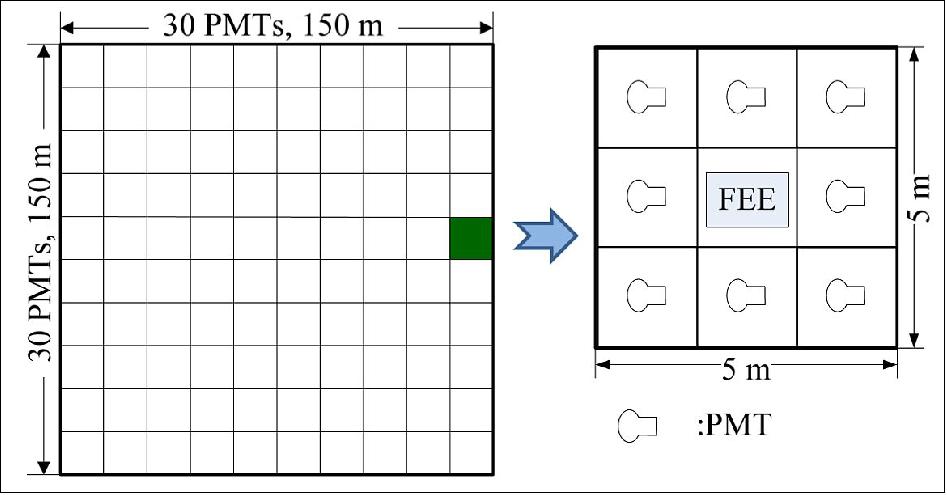
Both precise time and charge measurement is required in the WCDA readout electronics. We need to read out a total of 3600 PMT channels scattered within a large area, and the RMS of time measurement is required to be better than 0.5 ns, which means precise clock distribution and phase alignment in a large scale is paramount. Besides, data, commands, and clocks need to be transferred over a long distance (hundreds of meters), so the transmission quality and the system complexity are great concerns. To reduce the number of signal cables, we decide to propose a new architecture, instead of employing the traditional trigger structure that requires receiving hit information from front ends and feeding trigger signals back. Furthermore, the large input dynamic range (1~ 4000 PE) is also a great challenge, compared with the readout electronics for the WCDAs in other experiments.
Item | Requirement |
Bin size of time measurement | <1 ns |
Considering the situation in the read out of the WCDA in LHAASO, the following difficulties need to be overcome with novel methods and techniques:
1) precise time and charge measurement over an ultra large dynamic range;
2) high-quality clock distribution and phase alignment;
3) long distance transmission of clocks, commands, and huge amount of data;
4) new trigger electronics design.
WCDA Readout Electronics
The architecture of the WCDA readout electronics is shown in Figure 13. For each WCDA pond, 100 front end electronics modules are located above water, very close to the PMTs. Each FEE is responsible for the signal readout for 9 PMTs within one detector unit in Figure 12. The signal from the PMT is directly digitized by the FEE, and then transmitted to the clock and data transferring module (CDTM) in the control room. Signal transmission is based on fibers (hundreds of meters long) to guarantee a good transmission quality. Special methods are applied to address the issue of large dynamic range in FEEs, which will be presented in posterior sections.

Each CDTM collects data from 10 FEEs and then transfers the data to the trigger module; it also functions as the bridge for communication between the FEEs and the control system for commands transferring as well as system monitoring. Due to the complicated phenomena of cosmic ray showers, a high flexibility of trigger electronics is required to accommodate different potential trigger patterns. Invoked by the “triggerless” idea, we propose a new trigger electronics structure to achieve a good flexibility.
As mentioned above, a high time measurement resolution better than 1 ns is required over all the 3600 FEE channels. Therefore, we need to achieve a high quality clock distribution. Based on a simplified White Rabbit (WR) protocol, we employed an adaptive phase adjustment method to precisely align the clock phases. Besides, absolute time information needs to be included in the measurement results to identify an air shower event. We receive the signal from the global positioning system (GPS), and use it to discipline a rubidium clock source to generate the system clock reference, as shown in Figure 13. Detailed information is included in following sections.
Measurement Method
The PMT signal amplitude would vary from 1 PE to 4000 PE while the discrimination threshold is as low as 0.25 PE. It means that a resolution of 16 bits is required on the overall system performance, which is very difficult to achieve. To guarantee a good measurement resolution, especially for small signals (~ 1 PE), we employ two readout channels for each PMT: one is for the anode and the other is for a dynode (e.g. Dynode 10), as shown in Figure 14.
By adjusting the gains of the buffers in the two readout channels, the anode channel can effectively cover a range of 1~133 PE. while the Dynode 10 channel covers a range of 30 ~4000 PE. A total dynamic range of 4000 is achieved, and there exists enough overlap between the two channels. Since the dynamic range has been reassigned to two smaller scales, the requirement on the electronics is greatly reduced. The PMT signal from the anode is also used for time measurement. After passing through the discrimination circuits, the hit signal is digitized by a Time to Digital Converter (TDC) integrated in the FPGA.

As for precise charge measurement, we can employ the digital peaking method, in which the PMT is digitized by an ADC after amplification and shaping, and then the peak value of the amplitude can be sought based on the digital signal processing. We have worked on the measurement scheme, and finished the design of a FEE prototype is based on this method, as shown in Figure 15. The performance tests in the laboratory are underway.
Besides, we are also considering applying the Time-Over-Threshold (TOT) method in the signal measurement, and integrating the circuits within an ASIC (Application Specific Integrated Circuit) chip. The ASIC design is also in process.
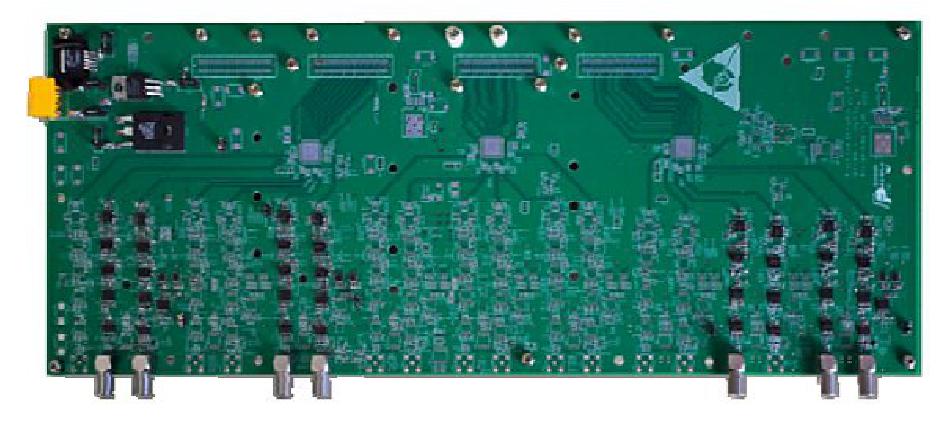
High Quality Clock Distribution
Since the FEEs are distributed over a large area, the delay difference among long signal transmission paths would cause non-aligned phases between the clock signals of different FEEs, which cannot be tolerated in high resolution time measurement. Besides, aging of the electronics and temperature variation would lead to fluctuation of the time delay. Thus, a precise real-time delay calibration and adjustment is needed.
A novel technology named White Rabbit is recently developed in the frame of CERN’s (and GSI’s) renovation projects. It is capable of controlling thousands of nodes over a few kilometers with a good timing accuracy. As for the timing, its kernel technique is based on the Precision Time Protocol (PTP, IEEE1588) and the Synchronous Ethernet technology. Invoked by the WR technique, we employ an adaptive delay measurement and compensation structure, as shown in Figure 16.
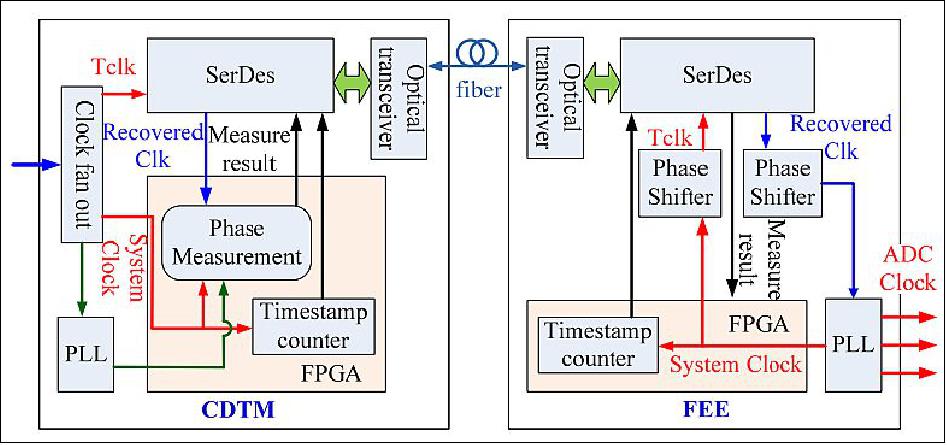
As aforementioned, each CDTM (Clock and Data Transferring Module) communicates with 10 FEEs over a distance of hundreds of meters. The CDTM (as the master) distributes the clock signals to the FEEs (as the slaves). Real time phase measurement is implemented in
an FPGA based on the digital DMTD (Dual Mixer Time Difference) measuring method. To further enhance the measurement resolution, an FPGA based TDC (resolution ~1 ns) is used. The phase measurement results are sent to the FEEs, in which the clock signal is adjusted for phase alignment. Digitally controlled phase locked loop (PLL) and precise delay line ASICs are used to achieve a tuning step of around 10 ps.
As a high-quality timing system, all the FEEs are required to be initiated and started at a precisely matched time point, which means a global reset must arrive at all the FEEs simultaneously. This is done with two steps. First, the clock signals are well aligned using the method just mentioned above. Second, a special timing sequence is designed, as shown in Figure 17. The master (CDTM) sends a 'Reset' pulse just after the PPS (pulse per second) signal. When this reset signal is detected by the slave (FEE), a flag named 'Reset ready' is asserted, with which the local reset signal in the slave can be generated after the next PPS signal is detected. To guarantee a synchronous reset of all the slaves, it is required that the uncertainty of the PPS signal is within one system clock cycle, while the uncertainty of the reset signal from the master can be as large as 1 s, which can be easily achieved.
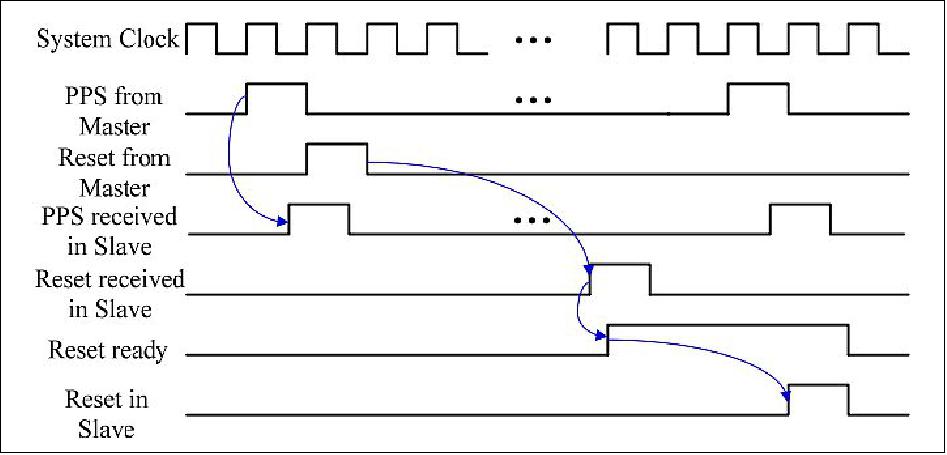
Besides, the CDTM is also responsible for collecting data from the FEEs, and transferring them to the trigger processing electronics. Considering an average raw event rate of 50 kHz, the total data rate for each CDTM would be as high as 50 kHz x 96 bit (packet size) x 9 (FEE channel number) x 10 = 432 Mbit/s. Considering the cost of 8 bit/10 bit encoding, the data rate is around 540 Mbit/s. Fibers are employed to achieve such a high transmission speed. Meanwhile, data, commands, and clocks are mixed together in the fiber based transmission line, so a good system simplicity is guaranteed.
New Trigger Electronics Design
In traditional trigger electronics such as in AMANDA and in BES III, hit signals are collected from FEEs for trigger processing, and global triggers need to be sent back to front ends for data readout. The complex phenomena of cosmic ray showers require a highly flexible trigger electronics, which can be modified online to accommodate different potential trigger patterns.
Invoked by the “triggerless” idea, we employ a new structure of trigger electronics. Complete data packets are collected from all the FEEs for trigger processing, so much more detailed information can be utilized to achieve a better trigger flexibility. Meanwhile, it also eliminates the need of feeding trigger signals back to front ends; thus a better system simplicity can be achieved. We plan to implement the triggerless idea with two potential methods. The first one is complete triggerless design. All the data from the FEEs are processed by the software in the DAQ. A best flexibility can be guaranteed by this method, of course accompanied by the requirement of more resource cost on data storage and processing. In the second method, we consider designing a trigger module to collect all the data form FEEs, and conducting real-time trigger processing with in an FPGA device. The recent development of data transmission and FPGA techniques makes it a feasible way. The abundant programmable logic resources in the FPGA lead to a reconfigurable trigger electronics. Besides, since a large partition of fake events are rejected by the trigger electronics, the requirement on the DAQ is also reduced.
We have finished the design of a trigger electronics prototype based on the second idea, and evaluate this design with a basic trigger pattern. As shown in Figure 18, the PMTs within one pond are divided into 16 overlapped trigger clusters (each cluster is a 12 x 12 PMT array). When more than 12 PMTs in any cluster are fired within any 250 ns duration, it will be recognized as a valid event and a global trigger signal will be generated.

We implement the above trigger pattern with the logic design in one FPGA (Xilinx Virtex-6 xc6vlx240t), as shown in Figure 19. Trigger processing and valid data selection are both integrated in the FPGA. One trigger module is required for each pond, which means the data from 100 FEEs are accumulated through 10 CDTMs to this module, rendering a raw data rate up to 5.4 Gsample/s. Fibers are also used here to guarantee a high data transfer rate.

Tests have been conducted on the data transmission performance and the validity of the trigger processing. As shown in Figure 20 is the system under test.

In summary, the requirement and challenge of the WCDA readout electronics in LHAASO are introduced. To overcome the difficulties, we propose special techniques, such as multiple gain readout, hybrid transmission of clocks and commands & data, precise clock phase alignment, and new trigger electronics. The architecture design of the electronics is presented in this paper. Technical design is in process, and we have finished the design of several electronics prototype, which are now under tests in the laboratory.
References
1) ”Green Light for LHAASO: China Approves Cosmic Ray Physics Exploration Project, ”IHEP, 18 September 2017, URL: http://english.ihep.cas.cn/lhaaso/News/202110/t20211026_286741.html
2) ”LHAASO - The Large High Altitude Air Shower Observatory,” IHEP/CAS, 2021, URL: http://english.ihep.cas.cn/lhaaso/
3) S. Vernettofor the LHAASO collaboration, ”Gamma Ray Astronomy with LHAASO,” XIV International Conference on Topics in Astroparticle and Underground Physics (TAUP 2015) IOP Publishing, Journal of Physics: Conference Series Volume 718(2016) 052043, https://iopscience.iop.org/article/10.1088/1742-6596/718/5/052043, URL: https://iopscience.iop.org/article/10.1088/1742-6596/718/5/052043/pdf
4) ”Chinese scientists' pursuit of cosmic rays opens windows on universe,” Space Daily, 24 October 2019, URL: https://www.spacedaily.com/reports/
Chinese_scientists_pursuit_of_cosmic_rays_opens_windows_on_universe_999.html
5) LIU Jia, ”LHAASO discovers a dozen PeVatrons and photons exceeding 1 PeV and launches ultra-high-energy gamma era,” CAS, 17 May, 2021, URL: https://english.cas.cn/head/202105/t20210517_269432.shtml
6) Cao, Zhen, Aharonian, F. A., An, Q., Axikegu, Bai, L. X., Bai, Y. X., Bao, Y. W., Bastieri, D., Bi, X. J., Bi, Y. J., Cai, H., Cai, J. T., Cao, Zhe, Chang, J., Chang, J. F., Chang, X. C., Chen, B. M., Chen, J., Chen, L., Chen, Liang, Chen, Long, Chen, M. J., Chen, M. L., Chen, Q. H., Chen, S. H., Chen, S. Z., Chen, T. L., Chen, X. L., Chen, Y., Cheng, N., Cheng, Y. D., Cui, S. W., Cui, X. H., Cui, Y. D., Dai, B. Z., Dai, H. L., Dai, Z. G., Danzengluobu, della Volpe, D., D'Ettorre Piazzoli, B., Dong, X. J., Fan, J. H., Fan, Y. Z., Fan, Z. X., Fang, J., Fang, K., Feng, C. F., Feng, L., Feng, S. H., Feng, Y. L., Gao, B., Gao, C. D., Gao, Q., Gao, W., Ge, M. M., Geng, L. S., Gong, G. H., Gou, Q. B., Gu, M. H., Guo, J. G., Guo, X. L., Guo, Y. Q., Guo, Y. Y., Han, Y. A., He, H. H., He, H. N., He, J. C., He, S. L., He, X. B., He, Y., Heller, M., Hor, Y. K., Hou, ....,Zuo, X.) ”Ultrahigh-energy photons up to 1.4 petaelectronvolts from 12 λ-ray Galactic sources,”Nature, Published: 17 May 2021, https://doi.org/10.1038/s41586-021-03498-z
7) ”Water Cherenkov Detector Array at Large High Altitude Air Shower Observatory Now in Operation,” IHEP, 7 January 2021, URL: http://english.ihep.cas.cn/nw/han/y21/202101/t20210107_298072.html
8) F. Aharonian, Q. An, Axikegu, L.X. Bai, Y.X. Bai, Y.W. Bao, D. Bastieri, X.J. Bi,Y.J. Bi, H. Cai, J.T. Cai, Z. Cao, , Z. Cao, J. Chang, J.F. Chang, X.C. Chang,B.M. Chen, J. Chen, L. Chen, L. Chen, L. Chen, M.J. Chen, M.L. Chen, Q.H. Chen,S.H. Chen, S.Z. Chen, T.L. Chen, X.L. Chen, Y. Chen, N. Cheng, Y.D. Cheng, S.W. Cui, ...X. Zhu, (The LHAASO Collaboration), ”Performance of LHAASO-WCDA and Observation of Crab Nebula as a Standard Candle,” Chinese Physics C, Vol. URL: https://arxiv.org/pdf/2101.03508.pdf
9) ”LHAASO Launches First Detectors to Decode Cosmic-ray Origins,” LHAASO News & Events, 22 April 2019, URL: http://english.ihep.cas.cn/lhaaso/News/202110/t20211026_286766.html
10) ZHAO Lei, LIU Shu-Bin, AN Qi, ”Proposal of the Readout Electronics for the WCDA in LHAASO Experiment,” 2013, URL: https://arxiv.org/ftp/arxiv/papers/1307/1307.0312.pdf
The information compiled and edited in this article was provided by Herbert J. Kramer from his documentation of: ”Observation of the Earth and Its Environment: Survey of Missions and Sensors” (Springer Verlag) as well as many other sources after the publication of the 4th edition in 2002. - Comments and corrections to this article are always welcome for further updates (eoportal@symbios.space).